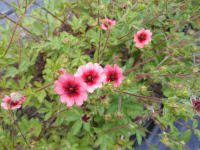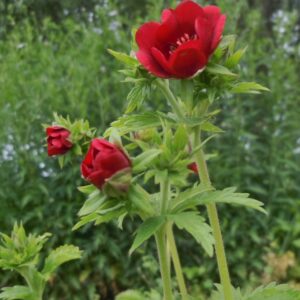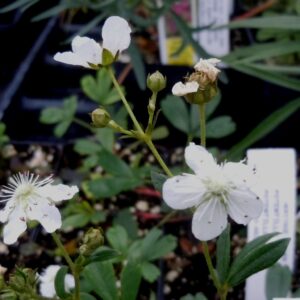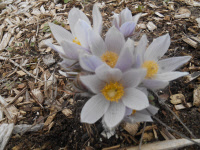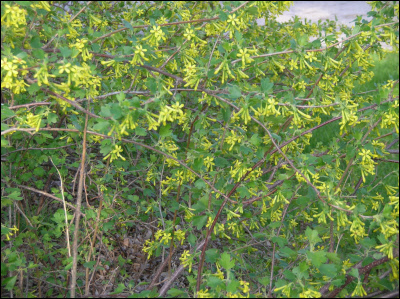Drought, Xeric & Dry Soil Plants
Showing 89–96 of 126 results
-
Polemonium brandegeei Brandegee’ Jacobs-ladder, Yellow sky pilot Z 4-8
Hanging, tubular yellow, sometimes white blooms over frilly foliage, May-July
OUT OF STOCK
Hanging, tubular yellow, sometimes white blooms over frilly foliage, May-July
Size: 8” x 10”
Care: sun to part shade in very well-drained soil
Native: CO, NM, SD, UT, WY
Wildlife Value: attracts bees, butterflies & mothsCollected by Townshend Stith Brandegee in the ‘Valley of the Rio Grande, on the Los Pinos Trail’ c. 1870. Brandegee then sent it to Harvard botanist Asa Gray who identified and named it to honor its collector.
-
Polygonatum multiflorum Solomon’s seal Z 4-10
Dangling dainty white bells in June followed by black fruit on the arching stem. The leaves “make a fine mass of elegant foliage,” Sanders, 1913.
Dangling dainty white bells in June followed by black fruit on the arching stem. The leaves “make a fine mass of elegant foliage,” Sanders, 1913.
Size: 5' x 10"
Care: shade in fertile, humusy, well-drained soil. Good dry shade plant
Native: Europe and AsiaGreek physician Dioscorides named Polygonatum in the 1st century, which means “many jointed” referring to scars on the rhizome. Medieval herbalists opined that Biblical figure Solomon put scars on the rhizome to demonstrate the plant’s curative powers. P. multiflorum cultivated in English gardens by 1450. In 1596 English herbalist Gerard endorsed its use to repair broken bones – mix the pulverized root and drink it with ale to “gleweth together the bones in very short space.” He also claimed fresh stamped root of Polygonatum would cure cuts and bruises for “women’s willfulness in stumbling on their hasty husband’s fists.” According to Culpepper, Italian wives “much used” this remedy. American gardens since 1700’s.
-
Potentilla atrosanguinea Himalayan cinquefoil Z 5-8
Open pink cups in June-July
Open pink cups in June-July
Size: 18-24" x 24"
Care: Sun well-drained soil
Native: HimalayasPotentilla is Latin meaning powerful referring to medicinal properties. Potentillas used by dentists in the 16th century to reduce pain according to Gerard, English herbalist. Per Culpepper, 17th century English herbalist potentilla is to be used if Jupiter is ascending and the moon is “applying to him.” Atrosanguinea 1st collected in its native Nepal in 1822.
-
Potentilla rupestris syn. Drymocallis rupestris Rock cinquefoil, Siberian tea Z 5-8
White, single rose-like saucer flowers with prominent yellow stamens flowering atop leafless stems. Blooms in early summer.
White, single rose-like saucer flowers with prominent yellow stamens flowering atop leafless stems. Blooms in early summer.
Size: 10-20" x 12"
Care: sun to part shade in well-drained to moist well-drained soil
Native: Europe, Asia & mountains of western No. AmericaPotentilla is Latin meaning “powerful” referring to medicinal properties. Rupestris means “rock loving.” This species 1st identified in literature in 1650. Russians used the leaves to brew tea.
-
Potentilla thurberi Scarlet cinquefoil Z 5-9
Loose clusters of Cabernet-red saucers blooming atop tall stems, elevating the small saucer-like flowers to make them more visible. Blooms from June to September.
Loose clusters of Cabernet-red saucers blooming atop tall stems, elevating the small saucer-like flowers to make them more visible. Blooms from June to September.
Size: 30" x 12"
Care: full sun in well-drained soil
Native: Arizona & New MexicoPotentilla is Latin meaning powerful referring to medicinal properties. This species collected before 1880’s.
-
Potentilla tridentata syn. Sibbaldiopsis tridentate Three-toothed cinquefoil Z 2-7
Clusters of white, single rose-like saucer flowers spring and early summer on this dainty-appearing perennial. Its glossy evergreen leaves tinge red in fall and winter.
Clusters of white, single rose-like saucer flowers spring and early summer on this dainty-appearing perennial. Its glossy evergreen leaves tinge red in fall and winter.
Size: 6" x 12" spreading by runners-can become a groundcover.
Care: sun in well-drained to moist well-drained acidic soil.
Native: New England to Upper Great Lakes, north to the Arctic, Appalachian Mountains of Georgia, Wisconsin native.
Awards: Cary Award Distinctive Plants for New EnglandDescribed by Kew’ Botanic Garden’s 1st botanist William Aiton (1731-1793) Hortus Kewensis vol 2 p. 216 (1789), who wrote that it came from Benjamin Bewick’s “curious botanic garden” in Clapham. Introduced it in 1776.
-
Pulsatilla patens syn. Anemone patens Eastern pasque flower Z 3-7
Up-facing blue-violet bells in early spring emerge from foliage decorated with silky hairs.
ARCHIVED
Note: This is a plant not currently for sale. This is an archive page preserved for informational use.
Up-facing blue-violet bells in early spring emerge from foliage decorated with silky hairs.
Size: 8-12” x 4-6" slow to grow, so be patient
Care: sun in moist well-drained to well-drained soil
Native: northern Great Plains including WI, Siberia, AlaskaThe name Pasque is Old French for Easter referring to the spring bloom time. Patens means “spreading.” South Dakota honors this as its state flower.
Collected for gardens prior to 1753. The Blackfoot made a decoction of this plant to speed a baby’s delivery and applied crushed leaves to skin to remedy irritation. Omaha applied fresh, crushed leaves as a poltice for rheumatism. -
Ribes aureum syn. Ribes odoratum Clove currant Z 3-8
Early to mid-spring yellow flowers shaped like a tube with 5 petals opening wide at the ends smother the shrub giving off a sweet, clove-scented fragrance – heavenly. Ships only in spring.
Early to mid-spring yellow flowers shaped like a tube with 5 petals opening wide at the ends smother the shrub giving off a sweet, clove-scented fragrance – heavenly. Ships only in spring.
Size: 6' x 6' spreading
Care: Sun in moist well-drained to well-drained soil.
Native: west-central US
Wildlife Value: Attracts bees, butterflies and hummingbirds for nectar. Small mammals eat the berries. Immune to Walnut toxinsMany tribes ate the berries. Shoshone and Paiute used the shrub’s inner bark to heal sores and swellings. Meriwether Lewis on the Lewis & Clark Expedition found this in 2 locations – “near the narrows of the Columbia” April 16 1806, now Klickitat County Washington, and on July 29, 1805 in Montana.
**LISTED AS OUT OF STOCK BECAUSE WE DO NOT SHIP THIS ITEM. IT IS AVAILABLE FOR PURCHASE AT OUR RETAIL LOCATION.



